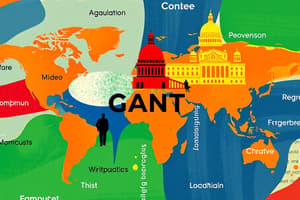Podcast
Questions and Answers
How many categorical grants were distributed by the federal government in 2014?
How many categorical grants were distributed by the federal government in 2014?
- 1,099
- 1,078 (correct)
- 24
- 21
Block grants accounted for 10 percent of total federal grant outlay by 2014.
Block grants accounted for 10 percent of total federal grant outlay by 2014.
True (A)
What grant program replaced the Aid to Families with Dependent Children (AFDC) in 1996?
What grant program replaced the Aid to Families with Dependent Children (AFDC) in 1996?
Temporary Assistance for Needy Families (TANF)
The number of block grants increased from six in 1981 to _____ in 1989.
The number of block grants increased from six in 1981 to _____ in 1989.
Match the years with their corresponding block grant counts:
Match the years with their corresponding block grant counts:
What is a reason cited for the popularity of categorical grants over block grants?
What is a reason cited for the popularity of categorical grants over block grants?
The Obama administration criticized categorical grants for their lack of accountability mechanisms.
The Obama administration criticized categorical grants for their lack of accountability mechanisms.
What was the main criticism of block grants as mentioned in the information?
What was the main criticism of block grants as mentioned in the information?
What is the annual cap on federal funding for the TANF block grant?
What is the annual cap on federal funding for the TANF block grant?
The AFDC program had a funding cap on federal reimbursements to states.
The AFDC program had a funding cap on federal reimbursements to states.
What reform did Paul Ryan propose during his tenure to potentially save the federal government money?
What reform did Paul Ryan propose during his tenure to potentially save the federal government money?
Unfunded mandates impose obligations on state and local governments without fully compensating them for the ______.
Unfunded mandates impose obligations on state and local governments without fully compensating them for the ______.
Match the following terms with their definitions:
Match the following terms with their definitions:
Which of the following describes the effect of block grants?
Which of the following describes the effect of block grants?
Set-asides are used to enhance the programmatic flexibility of block grants.
Set-asides are used to enhance the programmatic flexibility of block grants.
What are the potential penalties for failing to comply with crosscutting mandates?
What are the potential penalties for failing to comply with crosscutting mandates?
What is the estimated cost for states regarding the re-issuing of DL/IDs and implementing new identity verification procedures?
What is the estimated cost for states regarding the re-issuing of DL/IDs and implementing new identity verification procedures?
Only thirty-eight states were in full compliance with Real ID as of December 2018.
Only thirty-eight states were in full compliance with Real ID as of December 2018.
What term have some federalism scholars used to describe the use of mandates by the federal government?
What term have some federalism scholars used to describe the use of mandates by the federal government?
The Clery Act requires colleges and universities to disclose information about campus _____
The Clery Act requires colleges and universities to disclose information about campus _____
What does the Clery Act aim to provide information about?
What does the Clery Act aim to provide information about?
The federal government has fully funded the implementation of Real ID for states.
The federal government has fully funded the implementation of Real ID for states.
Who was the Clery Act named after?
Who was the Clery Act named after?
Match the following elements with their respective descriptions:
Match the following elements with their respective descriptions:
What is the primary consequence if a state or local government fails to meet federal requirements?
What is the primary consequence if a state or local government fails to meet federal requirements?
The Clean Air Act allows the federal government to enforce air quality regulations directly in all states.
The Clean Air Act allows the federal government to enforce air quality regulations directly in all states.
What law was enacted in 1995 to limit unfunded federal mandates on state and local governments?
What law was enacted in 1995 to limit unfunded federal mandates on state and local governments?
The _____ Act of 2005 requires standardized features on driver’s licenses and identification cards for security purposes.
The _____ Act of 2005 requires standardized features on driver’s licenses and identification cards for security purposes.
Match the following acts with their primary focus:
Match the following acts with their primary focus:
What was the outcome of the 2017 Unfunded Mandates and Information Transparency Act?
What was the outcome of the 2017 Unfunded Mandates and Information Transparency Act?
Federal mandates have decreased in number since the 1970s.
Federal mandates have decreased in number since the 1970s.
What authority does Title VI of the Civil Rights Act give to the federal government?
What authority does Title VI of the Civil Rights Act give to the federal government?
What is a characteristic of categorical grants?
What is a characteristic of categorical grants?
Block grants come with more stringent federal regulations compared to categorical grants.
Block grants come with more stringent federal regulations compared to categorical grants.
What federal program increased significantly in funding from $43.8 billion in 1990 to $320 billion in 2014?
What federal program increased significantly in funding from $43.8 billion in 1990 to $320 billion in 2014?
General revenue sharing had the least restrictions on the use of federal grants from 1972 to 1986, distributing upwards of $_____ billion.
General revenue sharing had the least restrictions on the use of federal grants from 1972 to 1986, distributing upwards of $_____ billion.
Match the following types of federal grants with their characteristics:
Match the following types of federal grants with their characteristics:
Which of the following is NOT an example of a categorical grant?
Which of the following is NOT an example of a categorical grant?
Federal grants have steadily increased in funding from the 1960s to the present.
Federal grants have steadily increased in funding from the 1960s to the present.
What two types of federal grants provide funding for skills training and infrastructure maintenance?
What two types of federal grants provide funding for skills training and infrastructure maintenance?
What is the primary purpose of federal intergovernmental grants?
What is the primary purpose of federal intergovernmental grants?
Unfunded mandates provide financial compensation for state compliance.
Unfunded mandates provide financial compensation for state compliance.
What type of grants were primarily used by the federal government before cash grants?
What type of grants were primarily used by the federal government before cash grants?
Federal intergovernmental grants are often likened to a __________, while unfunded mandates are likened to a __________.
Federal intergovernmental grants are often likened to a __________, while unfunded mandates are likened to a __________.
Which of the following institutions were established as land-grant universities?
Which of the following institutions were established as land-grant universities?
Cash grants have been the main form of federal intergovernmental transfers since the early 20th century.
Cash grants have been the main form of federal intergovernmental transfers since the early 20th century.
Name one of the black land grant universities established in 1890.
Name one of the black land grant universities established in 1890.
Flashcards
Federal Intergovernmental Grants
Federal Intergovernmental Grants
Financial assistance from the federal government to state and local governments, used to encourage specific actions or programs.
Unfunded Mandates
Unfunded Mandates
Federal requirements imposed on state and local governments, often without funding to cover the costs.
Land Grants
Land Grants
Grants provided to states in the form of land, often used for infrastructure projects or education.
Cash Grants
Cash Grants
Signup and view all the flashcards
Federal Influence on State Actions
Federal Influence on State Actions
Signup and view all the flashcards
Evolution of Federal Intergovernmental Grants
Evolution of Federal Intergovernmental Grants
Signup and view all the flashcards
Land Grants for Infrastructure
Land Grants for Infrastructure
Signup and view all the flashcards
Land-Grant Universities
Land-Grant Universities
Signup and view all the flashcards
Categorical Grants
Categorical Grants
Signup and view all the flashcards
Block Grants
Block Grants
Signup and view all the flashcards
General Revenue Sharing
General Revenue Sharing
Signup and view all the flashcards
Federal Grant
Federal Grant
Signup and view all the flashcards
Growth of Federal Grants
Growth of Federal Grants
Signup and view all the flashcards
Federal Government's Preference
Federal Government's Preference
Signup and view all the flashcards
Examples of Federal Grant Use
Examples of Federal Grant Use
Signup and view all the flashcards
National Policy Influence
National Policy Influence
Signup and view all the flashcards
Categorical Grants Popularity
Categorical Grants Popularity
Signup and view all the flashcards
Political Advantage of Categorical Grants
Political Advantage of Categorical Grants
Signup and view all the flashcards
Greater Federal Control with Categorical Grants
Greater Federal Control with Categorical Grants
Signup and view all the flashcards
Lack of Accountability in Block Grants
Lack of Accountability in Block Grants
Signup and view all the flashcards
Preservation of Categorical Grants
Preservation of Categorical Grants
Signup and view all the flashcards
TANF Block Grant
TANF Block Grant
Signup and view all the flashcards
Creeping Categorization
Creeping Categorization
Signup and view all the flashcards
Partial Preemption
Partial Preemption
Signup and view all the flashcards
Crosscutting Mandate
Crosscutting Mandate
Signup and view all the flashcards
Uncapped Federal Funding
Uncapped Federal Funding
Signup and view all the flashcards
Clean Air Act and Unfunded Mandates
Clean Air Act and Unfunded Mandates
Signup and view all the flashcards
Set-Aside
Set-Aside
Signup and view all the flashcards
Unfunded Mandates Reform Act (UMRA)
Unfunded Mandates Reform Act (UMRA)
Signup and view all the flashcards
Cost Ceiling
Cost Ceiling
Signup and view all the flashcards
Real ID Act of 2005
Real ID Act of 2005
Signup and view all the flashcards
Real ID Act: Unfunded Mandate
Real ID Act: Unfunded Mandate
Signup and view all the flashcards
Intergovernmental Grants
Intergovernmental Grants
Signup and view all the flashcards
Federal Power: Withholding Funds or Lawsuits
Federal Power: Withholding Funds or Lawsuits
Signup and view all the flashcards
What are unfunded mandates?
What are unfunded mandates?
Signup and view all the flashcards
What is coercive federalism?
What is coercive federalism?
Signup and view all the flashcards
What is the Clery Act?
What is the Clery Act?
Signup and view all the flashcards
What is the Clery Act Compliance Division?
What is the Clery Act Compliance Division?
Signup and view all the flashcards
What is new federalism?
What is new federalism?
Signup and view all the flashcards
How does the federal government use grants?
How does the federal government use grants?
Signup and view all the flashcards
What's the issue with unfunded mandates?
What's the issue with unfunded mandates?
Signup and view all the flashcards
What does new federalism promote?
What does new federalism promote?
Signup and view all the flashcards
Study Notes
Learning Objectives
- Students will be able to explain the evolution of federal intergovernmental grants.
- Students will be able to identify the different types of federal intergovernmental grants.
- Students will be able to describe the characteristics of unfunded mandates.
Intergovernmental Grants
- National government often needs state and local participation to achieve goals.
- Grants provide positive financial incentives (like a "carrot").
- Grants incentivize states to meet national goals.
- Unfunded mandates impose requirements without compensation.
- Unfunded mandates are like a "stick" because of the threat of penalties.
Grants
- Land grants were used in the early 1800s to fund infrastructure projects (roads, railroads, bridges, canals).
- Land grants also supported the development of universities and colleges.
- Land grants were common in the South after the Civil War when funding was scarce.
- Cash grants gradually replaced land grants as the primary form of intergovernmental transfer.
- Cash grants are now a crucial aspect of modern federalism.
Categorical Grants
- Categorical grants are designed to control spending.
- These transfers subject recipients to strict administrative criteria and guide project selection for specific programs.
- Federal officials monitor performance and financial oversight.
- Medicaid and the food stamp program are examples of categorical grants.
- Grant recipients must make matching payments.
Block Grants
- Block grants have less stringent federal restrictions than categorical grants.
- Block grants provide more flexibility over grant usage.
- Workforce Investment Act and Surface Transportation programs are examples of block grants.
- Recipients of general revenue sharing face the least restrictions.
Federal Grant Funding Trends
- Federal grants increased significantly during the 1960s and 1970s.
- The rise in Medicaid funding was a major factor in the increase during the 1990s and 2000s.
- In 2014, health-related grant programs (such as Medicaid and CHIP) accounted for more than half of federal spending.
Unfunded Mandates
- Federal laws/regulations obligate state and local governments.
- These obligations often lack financial compensation.
- Unfunded mandates emerged in the 1960s, impacting numerous areas like the environment, civil rights, education, and homeland security.
- Unfunded mandates may include crosscutting mandates.
- These mandates can lead to punishment, grants suspension, or fines.
- An example is Title VI of the Civil Rights Act of 1964.
Unfunded Mandate Reform Act (UMRA)
- The UMRA aimed to limit unfunded mandates by subjecting mandates to greater scrutiny.
- Despite this, mandates continued.
- More costly mandates have appeared in recent years.
Real ID Act of 2005
- This act requires states to increase security for driver's licenses.
- The act created costs for states.
- Significant compliance issues remain.
The Clery Act of 1990
- This act requires colleges to report campus crime data publicly.
- The law mandates annual reports on campus security.
- The act protects student safety through public information.
Studying That Suits You
Use AI to generate personalized quizzes and flashcards to suit your learning preferences.




